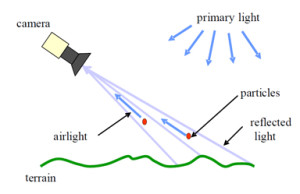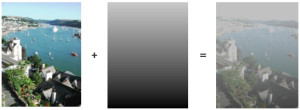Dmist Technology
The following is a short introduction to some aspects of Dmist’s patented video enhancement technology.

Under clear conditions, the only light entering a camera is that directly reflected by objects in the field of view. If haze, fog, drizzle, rain or smoke is present then some of the light originating from the primary light source (normally the sun, but could be artificial light sources) is scattered so that it enters the camera (termed “airlight”). The resultant image seen by the camera is essentially the sum of the original unaffected but attenuated scene image and the image of the airlight. The intensity of the airlight at any point in the image is a function of:
- Size and composition of scattering particles
- Concentration of particles
- Scene-camera range
- Illumination distribution
Adaptable to Changing Environmental Conditions
All these parameters are subject to change; some over the image area, and some over time as weather conditions change.
The amount of scattering is also dependent on the wavelength of the light.
There is a common belief that a dispersive medium such as fog scatters the light originating from the scene itself and so blurring the image to such an extent that original image recovery is very difficult (if not impossible). The simple simulation of a “foggy” scene shown below suggests that this is not the case. An image of a greyscale ramp (representing the general range depth of the scene) is added to the “ideal” image.
The result is a characteristic foggy scene with the background obscured and all colours appearing washed out. The technical and innovative challenge is to reverse this process; provided with just the “foggy” scene, estimate the contribution due to airlight scattering and so recover the original scene.

Under poor atmospheric conditions (haze, fog, drizzle, etc.), our technology estimates the contribution of the dispersive intervening medium to the observed image. This is determined using models based on the physics of atmospheric scattering. As the degree of degradation will change over time, this estimate is updated regularly. The scattering contribution is calculated for each of the three colour channels (red, green and blue). This permits the accurate reconstruction of true scene colours in the enhanced image.

Comments are closed.